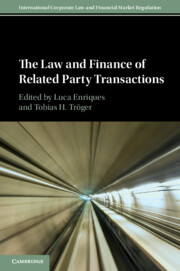Book contents
- The Law and Finance of Related Party Transactions
- International Corporate Law and Financial Market Regulation
- The Law and Finance of Related Party Transactions
- Copyright page
- Contents
- Contributors
- Acknowledgements
- 1 The Law and (Some) Finance of Related Party Transactions
- I Theoretical Framework and Policy Issues in Regulating Related Party Transactions
- 2 Corporate Control and the Regulation of Controlling Shareholders
- 3 Optimally Restrained Tunneling: The Puzzle of Controlling Shareholders’ “Generous” Exploitation in Bad-Law Jurisdictions
- 4 Powering Preemptive Rights with Presubscription Disclosure
- 5 Majority of the Minority Approval in a World of Active Shareholders
- 6 Institutional Investors as Minority Shareholders
- 7 Procedural and Substantive Review of Related Party Transactions
- 8 Related Party Transactions and Intragroup Transactions
- 9 Related Party Transactions in State-Owned Enterprises
- 10 Related Party Transactions in Insolvency
- II Regional- and Country-Specific Insights
- Index
- References
6 - Institutional Investors as Minority Shareholders
from I - Theoretical Framework and Policy Issues in Regulating Related Party Transactions
Published online by Cambridge University Press: 07 June 2019
- The Law and Finance of Related Party Transactions
- International Corporate Law and Financial Market Regulation
- The Law and Finance of Related Party Transactions
- Copyright page
- Contents
- Contributors
- Acknowledgements
- 1 The Law and (Some) Finance of Related Party Transactions
- I Theoretical Framework and Policy Issues in Regulating Related Party Transactions
- 2 Corporate Control and the Regulation of Controlling Shareholders
- 3 Optimally Restrained Tunneling: The Puzzle of Controlling Shareholders’ “Generous” Exploitation in Bad-Law Jurisdictions
- 4 Powering Preemptive Rights with Presubscription Disclosure
- 5 Majority of the Minority Approval in a World of Active Shareholders
- 6 Institutional Investors as Minority Shareholders
- 7 Procedural and Substantive Review of Related Party Transactions
- 8 Related Party Transactions and Intragroup Transactions
- 9 Related Party Transactions in State-Owned Enterprises
- 10 Related Party Transactions in Insolvency
- II Regional- and Country-Specific Insights
- Index
- References
Summary

- Type
- Chapter
- Information
- The Law and Finance of Related Party Transactions , pp. 136 - 180Publisher: Cambridge University PressPrint publication year: 2019

